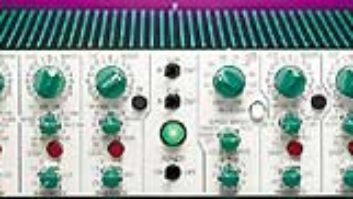Last October, we covered hi-res audio in general. Although there’s no technical definition for what is hi-res (apparently, the working one is “higher sample rate and bit resolution than a CD, or maybe Direct Stream Digital”), it seems at least part of the industry wants to settle on 24-bit/96 kHz resolution.

Granted, the Meyer-Moran engineering report “Audibility of a CD-Standard A/D/A Loop Inserted into High-Resolution Audio Playback” showed that people of varying ages and hearing acuity couldn’t reliably tell the difference between audio coming directly from DVD-A or DSD compared to that same mater ial going through 16-bit/44.1 kHz A/D/A conversion. However, as storage costs continue to decline and online bandwidth improves, there are fewer practical reasons not to choose 24/96.
Tellingly, Meyer-Moran noted the hi-res versions often did sound better because more care was taken in the production and mastering. If 24/96 does nothing more than convince record companies they don’t have to compress everything down to 6 dB of dynamic range, then hi-res will have value— nevermind CDs could be prepared with equal care. (It does seem odd that 96 kHz has been chosen over 88.1 kHz, given that the latter rate is twice that of the CD. And some will even argue that you need higher sampling rates than 96 kHz, which reminds me of movies that set up a sequel in the closing minutes… is a push for 192 kHz next?)
But there are two speed bumps on the way to 24-bit/96 kHz PCM. One is a “hi-res compliant” recording chain for PCM, although we’re pretty much there. Most existing DAWs can record at 96 kHz and higher. 24-bit recording has been a given for years; only the dithered export hits 16 bits. And while one could argue that converting 96 kHz signals to 44.1kHz introduces errors, today’s data conversion technology makes that argument moot. Furthermore, DAW engines typically go well beyond the requirements of hi-res. 32-bit floating bit and 64-bit engines are common; either one is all you need. However, going hi-res isn’t just about clicking a check box in a DAW’s preferences menu.
Although most audio interfaces are at least 96 kHz-compatible, track counts diminish as the interface tries to push more data through a USB or FireWire port. Realistically, USB 3.0 and FireWire 800 have enough bandwidth for the majority of recording applications, and for the remaining tasks, there’s Thunderbolt. However, Thunderbolt still hasn’t attained widespread traction; while it likely won’t go away, it’s currently heading toward niche-land. A complementary trend are “hi-res” interfaces that while still sticking to 96 kHz and/or 192 kHz sample rates, use higher-quality electronics. This recalls Meyer-Moran’s conclusion about hi-res inspiring engineers to pay more attention to detail.
As to plug-ins, many will work at elevated sample rates, but interfaces with onboard DSP may have sample rate limitations. Although one could argue on-board DSP isn’t something professionals use anyway, it’s convenient for functions like putting reverb into the singer’s headphones.
The other speed bump is DSD, although the software question gets dicier. With Genex/Desono apparently gone, Sonoma remains the main company offering DSD multitrack recorders with editing software and SA-CD edit master generation. Most engineers view DSD multitrack primarily as a better- sounding digital replacement for tape-based multitrack recorders, complete with analog mixing, because there are no comprehensive suites of “plug-ins” for DSD (at least not yet). Another option is synching multiple TASCAM DA-3000 stereo DSD/PCM recording devices, but as the outputs are analog, having a DSD master requires sending a mixer’s analog outs to a DSD recorder.
Once you have a mixed file in a DSD format, reality hits: It’s still a PCM world. Fortunately, Korg’s AudioGate software provides a clever format-conversion solution for taking DSD to PCM or compressed audio formats—it can even convert PCM recordings to generate a DSDIFF file useable as an SACD master, or convert an SACD DSDIFF master to a DSD disc’s DSF native file format.
If 24-bit/96 kHz becomes the new standard, our existing recording technology won’t have to undergo massive changes. However if DSD does take off, the irony is that it might help bring back analog if people do their capture and editing in DSD, then mix through an analog console and hardware units for processing on the way to a DSD master recorder. The bottom line? Don’t put that vintage hardware compressor on eBay…yet.
Craig Anderton has authored more than 30 books on technology and the arts. Check out his latest music videos at youtube.com/thecraiganderton.







